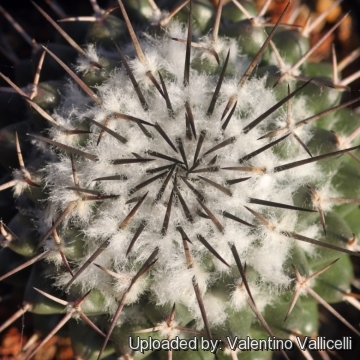
Mammillaria amajacensis Photo by: Valentino Vallicelli
Origin and Habitat: Valley of the Rio Amajac and near the village of. Santa Maria Amajac, Mun. Actopan, Puente de Dios, Hidalgo, (Mexico, Northern America).
Altitude: 1700-1950 metres above sea level.
Synonyms:
Description: Mammillaria amajacensisSN|23727]]SN|23727]] is a solitary cactus with small pinkish flowers in a ring around the sides of the stem. It is covered by crowded tubercles bearing 2 (or 4) rather long spines and abundant wool in their axils, so that the tubercles are almost completely covered.
Habit: Plants usually solitary (unless damaged).
Stems: Flattened-globose to short cylindrical but not apically depressed, dark-green and woolly at the top, 9-10 cm tall and broad.
Tubercles: Prominent, conical, dark blue green, without latex.
Axil: Densely woolly, especially near the apex and in the flowering zone.
Radial spine: Absent.
Central spine: Rather long, 2 (occasionally 4), needle-like, straight, pinkish-grey to dark-grey cwith blackish tips, to 15 mm long, lower ones longest.
Flower: Funnelform, in a ring around the sides at the top of the stem, pinkish cream with darker midveins. These appear to vary slightly, some plants have pink flowers while other have rather lighter flower with a clearer distinction between the darker midstripe and the rest of the petal.
Fruit: Borne in a circle near the middle of the plant, oblong, red.
Seed: Brown.
Bibliography: Major references and further lectures
1) Pilbeam J., “The Cactus file, Mammillaria” 6: 120, Cirio Pub. Services, 01/Dec/1999
2) John Pilbeam “Cacti for the Connoisseur: A Guide for Growers & Collectors” Timber Press, 01/lug/1987
3) James Cullen, Sabina G. Knees, H. Suzanne Cubey "The European Garden Flora Flowering Plants: A Manual for the Identification of Plants Cultivated in Europe, Both Out-of-Doors and Under Glass" Cambridge University Press, 11/Aug/2011
4) David R Hunt; Nigel P Taylor; Graham Charles; International Cactaceae Systematics Group. "The New Cactus Lexicon" dh books, 2006
5) Edward Anderson “The Cactus family” Timber Press, Incorporated, 2001
 Mammillaria amajacensis Photo by: Valentino Vallicelli
Mammillaria amajacensis Photo by: Valentino VallicelliSend a photo of this plant.The gallery now contains thousands of pictures, however it is possible to do even more. We are, of course, seeking photos of species not yet shown in the gallery but not only that, we are also looking for better pictures than those already present.
Read More... Cultivation and Propagation: In good conditions with careful application of water and excellent ventilation Mammillaria amajacensisSN|23727]]SN|23727]] grows without difficulty.
Growing rate: It is a slow growing species that rewards the patient grower with a beautiful displays of flowers since from an early age.
Soil: Requires good drainage provided by a very permeable open cactus soil (With not less than 50% grit content). Reduce the use of peat or other humus sources in the potting mixture.
Repotting: Repot every 2-3 years. Use small sized pots.
Feeding: During the beautiful season enrich the soil using a fertilizer rich in potassium and phosphorous, but poor in nitrogen, because this chemical element doesn’t help the development of succulent plants, making them too soft and full of water.
Watering: Water should be carefully applied and only when the soil is dry to the touch. Allow soil to drain thoroughly before watering again. Additionally, water should not be applied from above, as the feathery spines will retain water and add to rotting problems, but in good conditions with excellent ventilation, in bright light, it usually grows without particular difficulty. Do not water in the winter.
Light: Outside full sun or afternoon shade, inside it needs bright light, and some direct sun. Direct sun encourages flowering and heavy spine production.
Hardiness: Protect from frost. But it's hardy to -5°C if kept dry. A winter rest that allows the plant to shrivel (perhaps losing up to 25% of its summer height) will encourage flowering and long time survival.
Pests & diseases: It may be attractive to a variety of insects, but plants in good condition should be nearly pest-free, particularly if they are grown in a mineral potting-mix, with good exposure and ventilation. Nonetheless, there are several pests to watch for:
- Red spiders: Red spiders may be effectively rubbed up by misting the vulnerable plants every day
- Mealy bugs: occasionally they develop aerial into the new growth among the wool with disfiguring results, but the worst types develop underground on the roots and are invisible except by their effects.
- Scales: Scales are rarely a problem.
- Rot: it is only a minor problem with cacti if the plants are watered and “aired” correctly. If they are not, fungicides won't help all that much.
Propagation: Direct sow after last frost or (rarely) cuttings. Seeds germinate in 7-14 days at 21-27° C in spring, remove gradually the glass cover as soon the plants will be well rooted (ca 1-2 weeks) and keep ventilated, no full sun for young plants!












